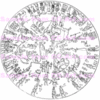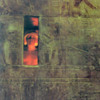 In the form of an intricately painted ceiling in the great Temple of Hathor at Dendera in central Egypt. It was discovered by French scholars brought by Napoleon in 1796 and now resides in the Louvre, Paris. The ceiling was painted in the time of the later Ptolemaic dynasty, possibly at the command of Queen Cleopatra herself. The ceiling is in the form of an astrological horoscope in which instead of the familiar twelve signs of the zodiac the gods of Egypt take their places in the celestial wheel.
In the form of an intricately painted ceiling in the great Temple of Hathor at Dendera in central Egypt. It was discovered by French scholars brought by Napoleon in 1796 and now resides in the Louvre, Paris. The ceiling was painted in the time of the later Ptolemaic dynasty, possibly at the command of Queen Cleopatra herself. The ceiling is in the form of an astrological horoscope in which instead of the familiar twelve signs of the zodiac the gods of Egypt take their places in the celestial wheel. The dating system used below has been adapted for modern use; along with a brief explanation of the astrological influence of each of the twelve gods. The dates begin at the annual flooding of the Nile, the beginning of the Egyptian year. This coincides with the return of the dog-star Sirius (the star of Isis) to the sky. It is therefore appropriate that Anubis, the dog- (or jackal-) headed deity commences the cycle.
- Anubis July 25-August 28 Determined, self-assured.
- Thoth August 19-September 27 Capable, wise, organized.
- Horus September 28-October 27 Confident, headstrong, obstinate.
- Wadjet October 28-November 26 Logical, dedicated, ambitious.
- Sekhmet November 27-December 26 Optimistic, eloquent, quarrelsome.
- Horus of the Horizon (Sphinx) December 27-January 25 Adaptable, disciplined, arrogant.
- Shu January 26-February 24 Cheerful, creative, indecisive.
- Isis February 25-March 26 Idealistic, intuitive, loyal.
- Osiris March 27-April 25 Witty, kindly, emotionally aloof.
- Amun-Ra April 26-May 25 Resolute, trustworthy, a leader.
- Hathor May 26-June 24 Emotional, charming, romantic.
- Bennu (Phoenix) June 25-July 24 Resilient, busy, self-renewing.
-Isis, Queen of Egyptian Magic, Jonathan Dee, page 138



